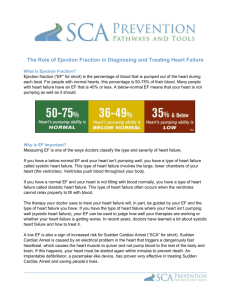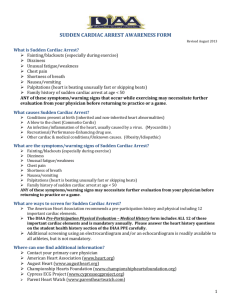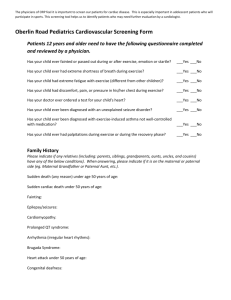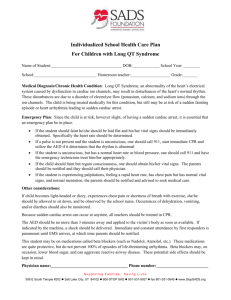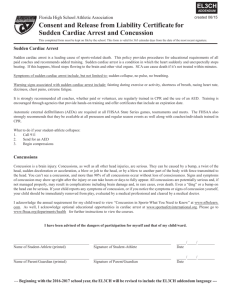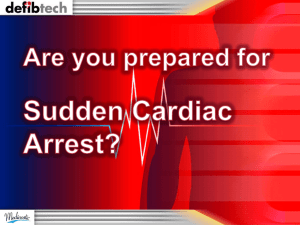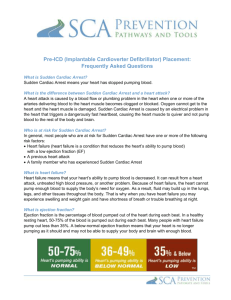SCA Patient Fact Sheet - American Heart Association
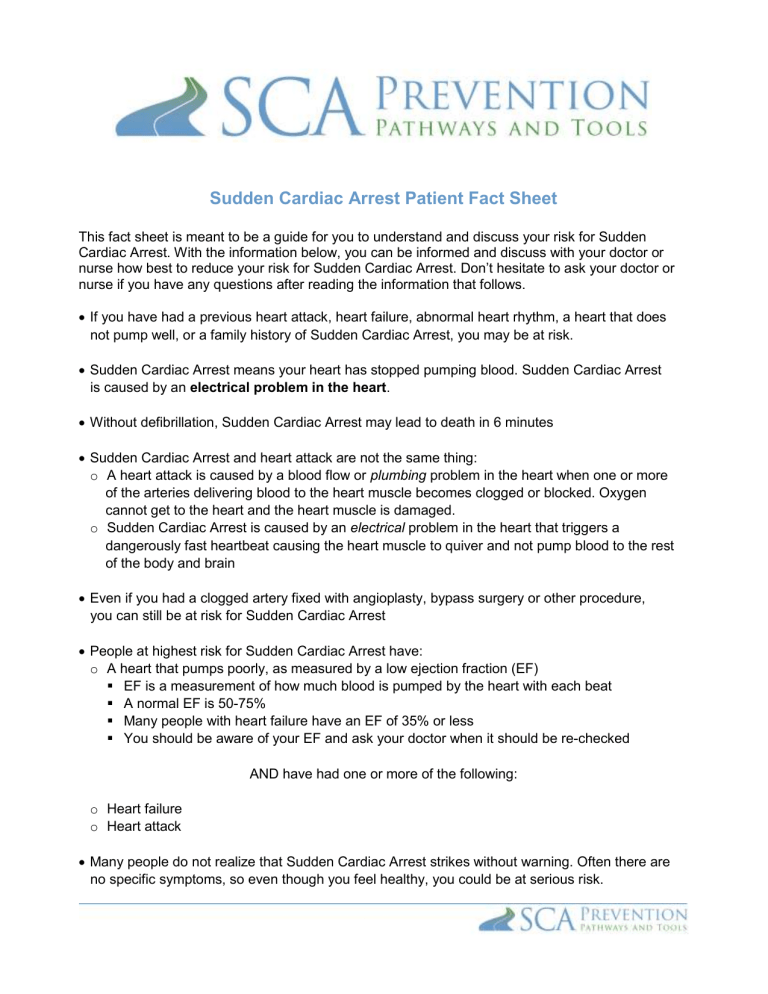
Sudden Cardiac Arrest Patient Fact Sheet
This fact sheet is meant to be a guide for you to understand and discuss your risk for Sudden
Cardiac Arrest. With the information below, you can be informed and discuss with your doctor or nurse how best to re duce your risk for Sudden Cardiac Arrest. Don’t hesitate to ask your doctor or nurse if you have any questions after reading the information that follows.
If you have had a previous heart attack, heart failure, abnormal heart rhythm, a heart that does
not pump well, or a family history of Sudden Cardiac Arrest, you may be at risk.
Sudden Cardiac Arrest means your heart has stopped pumping blood. Sudden Cardiac Arrest
is caused by an electrical problem in the heart .
Without defibrillation, Sudden Cardiac Arrest may lead to death in 6 minutes
Sudden Cardiac Arrest and heart attack are not the same thing: o A heart attack is caused by a blood flow or plumbing problem in the heart when one or more
of the arteries delivering blood to the heart muscle becomes clogged or blocked. Oxygen
cannot get to the heart and the heart muscle is damaged. o Sudden Cardiac Arrest is caused by an electrical problem in the heart that triggers a
dangerously fast heartbeat causing the heart muscle to quiver and not pump blood to the rest
of the body and brain
Even if you had a clogged artery fixed with angioplasty, bypass surgery or other procedure,
you can still be at risk for Sudden Cardiac Arrest
People at highest risk for Sudden Cardiac Arrest have: o A heart that pumps poorly, as measured by a low ejection fraction (EF)
EF is a measurement of how much blood is pumped by the heart with each beat
A normal EF is 50-75%
Many people with heart failure have an EF of 35% or less
You should be aware of your EF and ask your doctor when it should be re-checked
AND have had one or more of the following: o Heart failure o Heart attack
Many people do not realize that Sudden Cardiac Arrest strikes without warning. Often there are
no specific symptoms, so even though you feel healthy, you could be at serious risk.
The only useful way to treat Sudden Cardiac Arrest is defibrillation , which means an electrical
shock is delivered to your heart to return it to a normal heartbeat
Defibrillation within 6 minutes is critical to survive Sudden Cardiac Arrest; however, the average
response time to an emergency call is 6 to 12 minutes. Only 5% of people will survive a Sudden
Cardiac Arrest.
There are two main ways to defibrillate: automated external defibrillators (AEDs) and implantable
cardioverter defibrillators (ICDs)
Automated external defibrillators (AEDs) are portable devices that measure the electrical
activity of the heart and deliver defibrillation therapy if a fatal heart rhythm is detected. Most
Emergency Response Teams carry and use AEDs. Thanks to recent studies 1 showing their
life-saving role, AEDs are being placed in public gathering spots such as government centers,
airports, casinos, malls, stadiums, schools, and office buildings.
AEDs do not work by themselves and need to be operated by someone else. You cannot use
the AED on yourself.
Here is a picture of an AED
An implantable cardioverter defibrillator (ICD) is a small, pacemaker-like device placed in your body, under your skin, that can reset your heart’s rate and rhythm and, by doing so, can save
your life. Defibrillation is the best way to treat Sudden Cardiac Arrest. An ICD continuously
monitors your heart 24 hours a day. If your ICD detects a rhythm problem, it will send out
electrical signals to correct it. o Once it is implanted, an ICD will work by itself, but does require follow-up checks
Here is a diagram of an ICD
ICDs can be safe, reliable, and highly effective in treating Sudden Cardiac Arrest and may be a
good choice for you
Discuss with your doctor if an ICD is appropriate for your medical needs
There is a lot of information on the web. Ask your doctor for recommended websites.
Reference:
1 European Heart Rhythm Association; Heart Rhythm Society; Zipes DP, et al. ACC/AHA/ESC 2006 guidelines for
management of patients with ventricular arrhythmias and the prevention of sudden cardiac death: a report of the
American College of Cardiology/American Heart Association Task Force and the European Society of Cardiology
Committee for Practice Guidelines (Writing Committee to Develop Guidelines for Management of Patients With
Ventricular Arrhythmias and the Prevention of Sudden Cardiac Death). J Am Coll Cardiol.
September 5, 2006;
48(5):e247-346.
Developed by the SCA Prevention Medical Advisory Team.
This material is intended to be educational. It is not intended to replace the information provided to you by your healthcare providers and may not be directly applicable for your individual clinical circumstance.
Please refer to the manufacturers’ prescribing information and/or instructions for use for the indications, contraindications, warnings, and precautions associated with the medications and devices referenced in these materials.
Sponsored by Medtronic, Inc.
May 2007
UC200705523 EN
